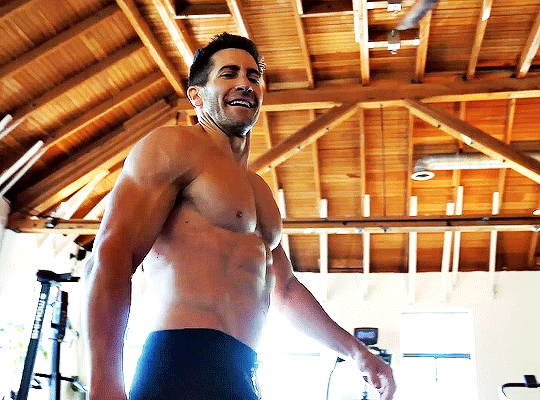Jake Gyllenhaal's Workout to Get Supremely Shredded for Road House
Jake Gyllenhaal has once again stunned fans with his jaw-dropping physique transformation for the upcoming Prime Video remake of the '80s classic Road House. Stepping into the role of Dalton, an MMA fighter turned bouncer, Gyllenhaal showcased a level of muscle definition and leanness that left everyone in awe. But how did he achieve such a monumental change in his physique?
Trainer Jason Walsh sheds light on the grueling workouts and dedication that were integral to sculpting Gyllenhaal's body for the role. Over a span of more than a year, Walsh and Gyllenhaal embarked on a rigorous training regimen that pushed the boundaries of physical fitness.
While fans may perceive Gyllenhaal's on-screen appearance as a continuous peak of fitness, Walsh emphasizes that there were unseen valleys and moments of hard work behind the scenes. Achieving and maintaining that level of ripped physique required a collaborative effort involving not just Gyllenhaal and Walsh, but also the support of a skilled team including stunt crews and a dedicated dietician, Ornella Sofitchouk.
Gyllenhaal acknowledges the importance of a collective effort, stating, "It takes a village." From intense training sessions to meticulous dietary planning, every aspect of Gyllenhaal's transformation was carefully orchestrated to emulate the look and agility of a seasoned UFC athlete.
As he embarked on this transformative journey, the actor's unwavering dedication to the grind was evident, proving that behind every awe-inspiring physique lies countless hours of hard work and unwavering determination. Road House promises not just action-packed entertainment, but also a visual testament to Jake Gyllenhaal's remarkable physical metamorphosis under the guidance of Jason Walsh.
Gyllenhaal's trainer, Walsh, emphasized the crucial role of the individual's dedication and effort in achieving fitness goals. According to Walsh, having top-notch training programs and a supportive team is essential, but ultimately, success boils down to the individual's commitment and hard work. In Gyllenhaal's case, his perseverance and dedication shone through as he underwent a rigorous training regimen to transform his physique.
The training program Gyllenhaal followed was meticulously structured, progressing through different phases aimed at enhancing his conditioning, building muscle, and honing sport-specific movement patterns essential for his on-screen performances.
The process, spanning over a year leading up to UFC 285, saw Gyllenhaal undergo significant physical changes, cutting down to five percent body fat from 205 to 184 pounds.
Walsh outlined the key exercises that contributed to Gyllenhaal's sculpted physique, with a focus on core-centric circuits to chisel his abs. However, it wasn't just intense workouts that shaped Gyllenhaal's body; a strategic nutrition plan played a vital role as well. Gyllenhaal had to bid farewell to his favorite indulgences and follow a carefully curated meal plan tailored to his caloric needs and dietary requirements.
Moreover, dietary adjustments were crucial, with Gyllenhaal switching to a plant-based protein formula due to digestive issues with whey supplements. Walsh, in collaboration with a nutritionist, devised a specialized meal plan that complemented Gyllenhaal's training regimen, ensuring he had the energy and nutrients necessary for his demanding workouts.
To sculpt his enviable abs, Gyllenhaal incorporated core-focused circuits into his routine, performing them 2 to 3 times a week for 3 to 4 rounds per session. This dedication to both training and nutrition underscored Gyllenhaal's commitment to achieving his fitness goals and attaining his desired physique.
Workout Routine for Full-Body Strength
These exercises will engage multiple muscle groups, helping you build a solid foundation of strength. Let's break down each move:
KB Overhead Carries
Duration: 60 meters
Press a pair of kettlebells overhead, wrists flexed.
Engage your core and glutes for stability.
Walk forward while focusing on a point just ahead of you on the floor.
Front-Rack KB Carries
Duration: 60 meters
Hold kettlebells at shoulder height with elbows close to your body.
Keep forearms perpendicular to the floor to engage the muscles.
Walk while maintaining tension and stability throughout your body.
Zercher Squats
Repetitions: 8 to 15
Hold a barbell in the crooks of your elbows.
Tighten your core and glutes.
Lower into a squat position until thighs are parallel to the floor.
Pause for 3 seconds before standing up and squeezing your glutes.
Split-Stance Physio-Ball Chops
Repetitions: 8 to 15 per side
Start in a kneeling position with one knee down and the other foot on the floor.
Hold a physio ball with arms wrapped around it.
Lift the raised knee slightly and perform chopping motions with the ball.
Engage your core throughout the movement to enhance stability.
This workout routine challenges different aspects of your strength, from overhead stability to lower body strength and core engagement. Push yourself through each exercise with proper form and control to maximize the benefits. Consider adding weights progressively as you get stronger.
Remember, consistency and proper form are key to seeing progress in your fitness journey. Stay committed, stay focused, and most importantly, enjoy the journey to a stronger and healthier version of yourself.






